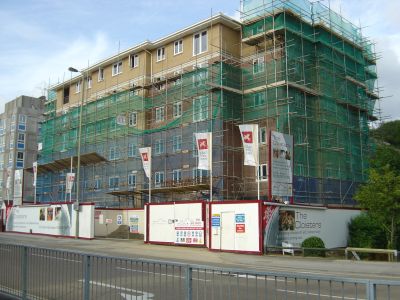The Cloisters is a new build development of 47 one and two bedroom flats built by Natta Country Homes in Farnborough. Priced at £155,950 upwards these flats are marketed as Luxury apartments to ideally suit London commuters, and with the Farnborough main line station (45 mins from waterloo) situated a stones through away, you might think they would sell like hot cakes.

Building work began last year, with the show home being open from Easter this year, and yet at the time of writing, according to the Land Registry’s latest data, they hadn’t sold a single unit. During the peak of the housing boom, properties like this were selling “off-plan” before even the first brick was laid…
So what has happened?
The problem is, prices of houses in the UK, and indeed many other countries (US, Spain, Ireland, Australia to name but a few) have completely lost touch with reality. In the years since the stock market bubble bursting in 2000 investors looked elsewhere for places to put their money, and with historically low interest rates, houses looked an attractive option. This massive influx of cash into the property market has subsequently caused the total value of all residential property in developed economies to increase by $30 trillion dollars, which is equivalent to 100% of those countries combined GDP. Not only does this completely dwarf any previous house price boom, but compare it to the stock market boom of the 1990s (where stock values increased by 80% over 5 years) and it looks like we may have the biggest financial bubble in history.
Unfortunately for our friends at The Cloisters in Farnborough, this isn’t their only bad news.
Bring on the Flats
In recent years the government has encouraged development on brown field sites, a consequence of this is that, as they are generally smaller in size, developers have been more inclined to build flats and apartments to maximise the amount of residential units they can build per unit of area, and thereby maximise their profits.
People in general do not aspire to live in a flat, they aspire to live in a detached house. The surge in supply of flats in recent years has been mostly driven by “buy-to-let” investors looking to cash in on the house price boom. However, in last year or so rental yields have fallen steeply, with the typical rent being somewhat less than the investor is paying on their interest-only mortgage. Some BTL investors were happy to make a loss the whole time their capital was still increasing in value, but in most places that has now stopped to. Since flats now account for 44% of all new residential building (up from just 16% in 1997), and BTL investors are no longer buying them in the numbers they once were, this has caused what can only be considered as a glut in new build flats.
Do your sums
Taking our example of The Cloisters in Farnborough, their estate agents are claiming you can expect to let out one of their 2 bedroom Somercote flats for £700 a month, and yet if you paid their asking price of £178,950, you would be facing a monthly payment on an interest only mortgage of at least £760 (85% LTV @ 6% interest), which implies a monthly loss of £60 before you even include any null periods or maintenance costs. Over the course of a year you could probably expect to make a several thousand pound actual loss in your cash flow, perhaps significantly more on paper if house prices go down.
If on the other hand, as a potential buyer, you decided to rent instead at the market rate of £700 a month, you would be saving yourself around £150 pound on the equivalent interest only mortgage (95% LTV @ 6%).
So what for the future?
Buyers (particularly first time buyers) are becoming wise to this, and are now choosing not to buy at inflated prices. As sales dry up, some vendors will try to sit it out and hold their prices, but others will eventually be forced to sell at a discount, and this of course will add downward pressure on prices.
So I think now it is almost certain that in some way or another house prices will need to start moving back towards their historical norms. This could be in the form of a prolonged stagnation in prices, or it may be a short sharp correction.
What is far from certain, is what effect this will have on the overall economy.
Source of Figures
The Economist “In come the waves” June 16th 2005.
The Economist “What goes up” May 12th 2005.